
New ground for chicken pastures

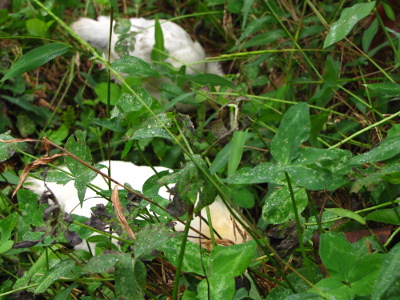 Our Light
Sussex chicks are
voracious. They're currently in our tiniest pasture, but I
thought for sure it would last them multiple weeks since the chicks
aren't even fully feathered. Instead, it looks like they'll need
fresh forage in less than a week.
Our Light
Sussex chicks are
voracious. They're currently in our tiniest pasture, but I
thought for sure it would last them multiple weeks since the chicks
aren't even fully feathered. Instead, it looks like they'll need
fresh forage in less than a week.
My original plan had
been to let Mark finish up the pasture running up the hill behind the
coop, but I really don't want to turn the chicks in there until they're
at least four or five weeks old --- that pasture lacks tender,
chick-friendly food and has too much predator pressure. The other
pasture attached to our chicks' coop was overgrazed by the Cuckoo Marans and has been seeded with
pasture plants that need some time to get established. What will
our Sussex chicks eat in the meantime?
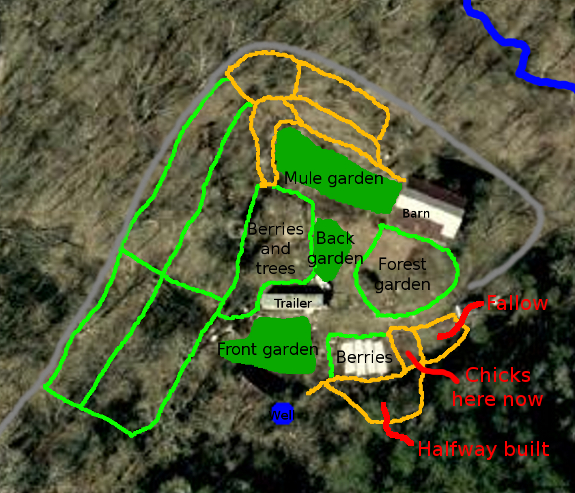
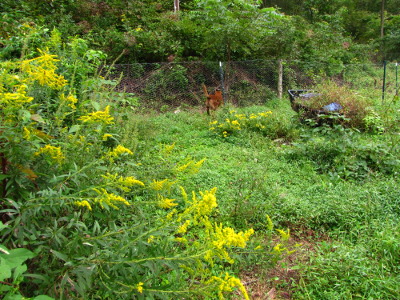 My eyes turn to the
semi-frequently mowed berry and fruit tree areas that bracket our
vegetable gardens. There's lots of chick-friendly forage
available on the ground and the chicks aren't big enough to do too much
damage (especially since the mulch in these areas has rotted into the
ground and needs to be refreshed.) I've been wishing I could run
chickens in there to deal with some insect problems, and we're sick of
mowing. The problem is fencing and housing.
My eyes turn to the
semi-frequently mowed berry and fruit tree areas that bracket our
vegetable gardens. There's lots of chick-friendly forage
available on the ground and the chicks aren't big enough to do too much
damage (especially since the mulch in these areas has rotted into the
ground and needs to be refreshed.) I've been wishing I could run
chickens in there to deal with some insect problems, and we're sick of
mowing. The problem is fencing and housing.
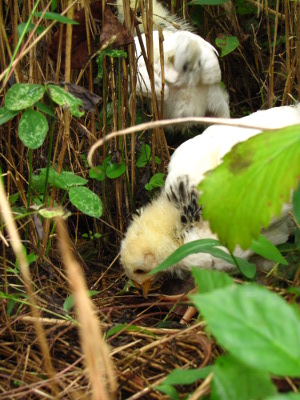 We could use chicken
tractors, but I think our chicks
need a tighter coop for at least a few more weeks, and they're already too big
to fit all fourteen in a yard-size tractor. Instead, I'm
pondering several options:
We could use chicken
tractors, but I think our chicks
need a tighter coop for at least a few more weeks, and they're already too big
to fit all fourteen in a yard-size tractor. Instead, I'm
pondering several options:
- Temporary fencing using the existing coop. I figure it would take me and Mark less than an hour to toss up some fencing around the berries adjacent to the chicks' current pasture. We have extra pea trellis material on hand to use if the deer come calling and can rustle up enough of the lightweight fence posts that we use for trellis posts and tomato stakes. After the chicks eat up the groundcover between the berry bushes, we could move the fencing to make an avenue across the driveway and then surround parts of the forest garden. By the time the chicks eat all that, surely they'll be big enough to run up on the hill.
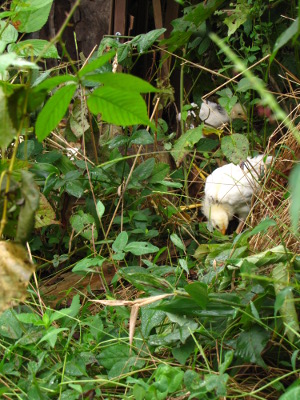 Permanent fencing and one or more new coops.
On the other hand, this time of year is a lull in our pasture
productivity, and we'll often want to have extra pasture areas.
So maybe it would be a good idea to fence these areas in
permanently? The problem there is that we'd have to build gates
(time consuming) and perhaps add one or more coops (even more time
consuming) since we wouldn't want permanent fencing crossing our
driveway. Plus, the area where the driveway ends in front of the
trailer is already pretty tight, and I'm not sure permanent fencing
along both sides of the driveway would be a good idea. On the
other hand, putting in the time to build permanent fences now would
save time in later years, and I suspect deer would be afraid to walk up
the driveway if it had fences on both sides.
Permanent fencing and one or more new coops.
On the other hand, this time of year is a lull in our pasture
productivity, and we'll often want to have extra pasture areas.
So maybe it would be a good idea to fence these areas in
permanently? The problem there is that we'd have to build gates
(time consuming) and perhaps add one or more coops (even more time
consuming) since we wouldn't want permanent fencing crossing our
driveway. Plus, the area where the driveway ends in front of the
trailer is already pretty tight, and I'm not sure permanent fencing
along both sides of the driveway would be a good idea. On the
other hand, putting in the time to build permanent fences now would
save time in later years, and I suspect deer would be afraid to walk up
the driveway if it had fences on both sides.
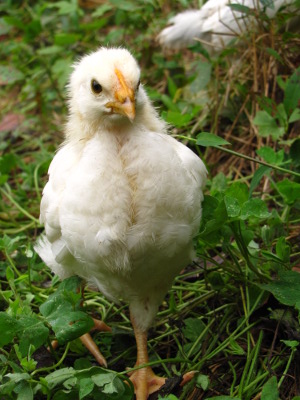 Portable coop with temporary
fencing. Another option would be to combine a portable
coop with temporary fencing, which would allow us to run the chicks all
the way over to the berry and tree area on the west side of the back
garden. The major bonus with pasturing this area is that we could
finally deal with some of the insects that hit our peach trees while
grazing more land that we're sick of mowing. The downside is that
a portable coop big enough for fourteen chickens would be heavy (and
harder to build than permanent coops.) Mark had an idea of making
a portable coop with two handles so it could be carried since dragging
definitely wouldn't be good enough in the tight spaces of our
yard. It almost seems simpler to just build an extra coop over
there if I want our chickens to graze that area.
Portable coop with temporary
fencing. Another option would be to combine a portable
coop with temporary fencing, which would allow us to run the chicks all
the way over to the berry and tree area on the west side of the back
garden. The major bonus with pasturing this area is that we could
finally deal with some of the insects that hit our peach trees while
grazing more land that we're sick of mowing. The downside is that
a portable coop big enough for fourteen chickens would be heavy (and
harder to build than permanent coops.) Mark had an idea of making
a portable coop with two handles so it could be carried since dragging
definitely wouldn't be good enough in the tight spaces of our
yard. It almost seems simpler to just build an extra coop over
there if I want our chickens to graze that area.
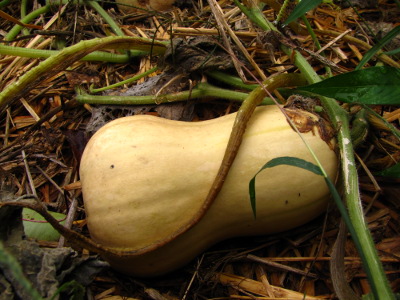 Any other ideas?
Additional pros and cons for the ideas above? At this instant,
I'm leaning toward temporary fencing around the berries to give us some
breathing space which we'd use to build permanent fencing around the
forest garden. Our butternuts need another week or so to finish
ripening anyway before we can take them off their dying vines.
But I'm always looking for better ideas.
Any other ideas?
Additional pros and cons for the ideas above? At this instant,
I'm leaning toward temporary fencing around the berries to give us some
breathing space which we'd use to build permanent fencing around the
forest garden. Our butternuts need another week or so to finish
ripening anyway before we can take them off their dying vines.
But I'm always looking for better ideas.
Want more in-depth information? Browse through our books.
Or explore more posts by date or by subject.
About us: Anna Hess and Mark Hamilton spent over a decade living self-sufficiently in the mountains of Virginia before moving north to start over from scratch in the foothills of Ohio. They've experimented with permaculture, no-till gardening, trailersteading, home-based microbusinesses and much more, writing about their adventures in both blogs and books.
Want to be notified when new comments are posted on this page? Click on the RSS button after you add a comment to subscribe to the comment feed, or simply check the box beside "email replies to me" while writing your comment.

I've always liked the idea of fencing panels. A five foot or longer section of chicken wire/netting/etc between two long but light, posts that you could drive in to set the panel in place. At the end of the need for that fenced area, the posts could be pulled up and all the panels stacked and carried away to the next place or to storage. I think chicken wire's flexibility would help with hills or around trees, but perhaps building them and moving them around might make more work than simply driving posts quickly and rolling out the wire.
I know it's costly but what about moveable fencing with some predator protection like the "electronet" or similar type, you can get them with a solar charged battery or maybe even use your own.
On the upside it would be easy to move and reuseable. Or better yet, if anyone you know has one borrow it and check it out.
Love your site.
Ikwig --- The more I think about it, the more I agree with you. Sure, temporary fencing will be more work in the long run, but it will be less up front work now and will let me experiment a lot before committing to a bigger project. I think I'm sold.
Anonymous --- The trouble with electric fencing is that it really works best in a big, open, lawn-like pasture. Any time electric fencing touches a tall weed, you lose the electrifying ability and your animals can get through. That means it would be tough to use in our convoluted yard and also in the brushy areas we'd like to turn into pastures. I figure if we're going to have to go through with a weedeater and cut lanes for electric fencing, we'd be better off just using a non-electrified option.